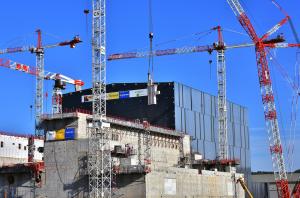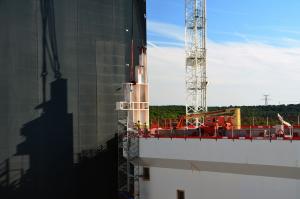Worksite
First pillars for the crane hall
16 Sep 2019
For the overhead cranes to deliver machine components into the Tokamak assembly pit, the rails that carry them need to be extended some 80 metres beyond the temporary wall of the Assembly Hall. The extension, part of a cladded steel structure supported by two parallel rows of ten steel pillars, will form a new volume within the Tokamak Complex — the Crane Hall where the cranes will travel back and forth as assembly work progresses inside the pit.
The lower pillar section (28-tonne, 13 metres in height) is slowly lifted by the mammoth crawler crane. The steel piece needs to be precisely oriented so that its boltholes can match with the 24 studs in the anchoring plinth.
On Wednesday 11 September, the lower section of the first pillar was anchored into the corbel on the south side of the Tokamak Building. Although the steel piece weighs only 28 tonnes (not much by ITER standards ...) a huge crawler crane, with a lifting capacity of 650 tonnes and a boom reaching more than a hundred metres in height, was brought in to perform the operation.
Once lifted from the ground, the pillar had to be precisely oriented so that its boltholes could match with the 24 anchors protruding from the concrete plinth in the corbel. A dozen specialists were ready to perform the delicate insertion operation and subsequent bolting. Like with most components—however heavy—nothing beats the precision of the human hand ...
The stair-like protrusions on the inner face of the pillars will support the rails carrying both overhead crane pairs (750-tonne and 50-tonne).
By Friday, three lower pillar sections, 13 metres in height, were in place. Each lower section will be topped by a 16-metre-high upper section which, in turn, will support five pre-assembled structural modules for the roof spanning a distance of close to 50 metres. In order to lift the huge modules, a second crawler crane, positioned on the northwest side of the Tokamak Complex, will work in tandem with the one already in place.
Designed to withstand the tremendous forces exerted by the movement of the travelling cranes, the finalized structure will weigh approximately 1,800 tonnes and should be completed by February 2020—one month before the official start of the machine assembly phase.



